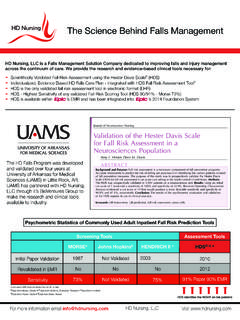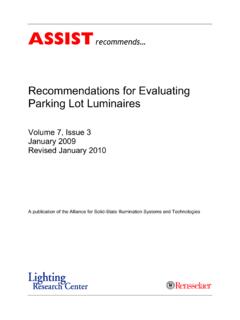Transcription of Vol. 6, Issue 7, July 2017 A Two level Task Scheduling ...
1 ISSN(Online): 2319-8753. ISSN (Print): 2347-6710. International Journal of Innovative Research in Science, Engineering and Technology (An ISO 3297: 2007 Certified Organization). Website: Vol. 6, Issue 7, July 2017. A Two level Task Scheduling Simulator for Grid Environment Sunita Rani1, P. K. Suri2. Assistant Professor, Department of CSE & IT, , Khanpurkalan, Sonepat, Haryana, India1. Retired Dean (Sc. /E&T) and Professor & Chairman (Department of Computer Science and Applications), Kurukshetra University, Kurukshetra, India2. ABSTRACT: Grid computing has caused the popularization of distributed and diversified mode of computing. Its focus is on solving big computing problems which requires huge computing resources. Simultaneous collection of so many computing resources at a same place is practically impossible. This factor has acted as a catalyst in the increasing popularity of grid computing. Preparing a grid of huge collection of computing resource is tedious and costly task.
2 Effective utilization of resources and computing of tasks within specified time limit is more tedious task than creation of grid. Mapping of tasks with required resources falls under the area of task Scheduling . In this paper, authors have proposed a two level Scheduling approach for task resource mapping in grid environment. At first level , tasks are mapped with cluster of resource and at the second level ; tasks are mapped with a specific resource. Authors have used Gridsim simulator to test and compare the proposed approach with existing one. Through simulation results, it has been analyzed that proposed multilevel Scheduling approach has outperformed the other approaches on all the relevant parameters. KEYWORDS: Grid computing, Scheduling , Gridsim, Multilevel;. I. INTRODUCTION. A computing grid is composed of wide range of computing resources. This interconnected pool of resources forms a grid of resources in the form of a layer. To manage this virtualized grid layer efficiently, there is a need of management system, which will handle the resources efficiently and maps the task with resources in such a way that task get completed within the stipulated time.
3 Moreover, size of grid can be varied exponentially. This has forced the need of efficient scheduler to handle the challenges of grid [1]. Grid computing has caused the emergence of distributed and diversified mode of computing to solve very big problem. Connectivity between distributed resources is achieved through internet and it provides live environment for researchers to execute their highly computing demand work. Diversified nature of resources is the forcing factor behind the sharing of resources [2]. It is the middleware of grid which provides the framework for loading and managing the desired resources and data for the user. Some of the IT related Issue which is encountered during implementation of grid is as follows: Selection of management policies Geographical location for deployment of resources Finalization of service level agreement Finding solution of scalability and adaptability Issue [3, 4]. Mapping of task with resources in grid environment is NP completeproblem which handles the elastic resource requirement of tasks using Grid's Virtual virtual organization refers to collection of diversified located resources which are following predefined rules under different heads [5].
4 The vital aim of Scheduling techniques in grid environment is to achieve efficient and cost effective finishing of scientific problems of diversified problems. The multilevel Scheduling in grid means mapping of jobs with different Copyright to IJIRSET 14846. ISSN(Online): 2319-8753. ISSN (Print): 2347-6710. International Journal of Innovative Research in Science, Engineering and Technology (An ISO 3297: 2007 Certified Organization). Website: Vol. 6, Issue 7, July 2017. available resources at different computational level at same or different geographically locations. It uses grid cluster agent and local resource manager for efficient mapping [6]. Paper organization is as follows: In the section II, authors have discussed the grid Scheduling related work found in literature. Proposed multilevel grid Scheduling has been discussed in section III. Section IV contains the information about gridsim simulator, results of simulation work. Finally, conclusion and future scope has been given in section V.
5 II. RELATED WORK. Scheduling algorithm always tries to find solution of optimization problem. It belongs to NP-complete class. Different researchers have contributed in the grid Scheduling work. In this section, authors have given a review of the work found in literature. Details are as follows: Bestavroset al. in [7] have proposed a Scheduling approach for distributed systems to satisfy the requirements of tasks. Proposed algorithm first tries to map task with resources in such a way that deadline got satisfied. If it is not able to map, then it finds the most suitable task resource mapping in which deadline violation should be minimum. Nodes are divided in categories like light loaded, medium loaded and heavily loaded based upon their present load. Based upon present situation, some probabilities are assigned to all nodes. This probability indicates the chances of task completion before deadline violation. Hsu et al. in [8] have proposed a task resource mapping technique for multiple workflows in grid environments.
6 Authors have tested proposed approach with a variety of simulation environment. They have compared the proposed work with Fairness_Dynamic and Rank_Hybd on parameters like makespan, SLR &win% in different situations. Leal et al. in [9] have given a meta-scheduler for mapping independent set of tasks with resources in the grid environment. Authors have discussed four decoupled and simple algorithm for mapping technique. Their approach neither requires the information about the processing capacity of node nor it consider the size of the task to be mapped. It only considers the past performance of the node. Wang et al. in [10] have given a dynamic Scheduling approach for grid environment. Authors have used probabilistic and deterministic based heuristics for task resource mapping. Focus of mapping technique was on minimizing the turnaround time. Das et al. in [11] have given an auction oriented resource allocation scheme. User bids for resources based upon the requirement of their task.
7 Their scheme composed of three components: User broker- this component manages the work of resource discovery, job management and bid. Grid service provider- this component provides the resource pool Local Market Auction:-this component act as a notice board where GSP can display the resources Jun et al. in [12] have given a multi agent based job Scheduling approach named ordinal sharing learning. Authors have used the concept of distributed learning approach to achieve the scalability in grid environment. Through simulation, authors have compared their proposed approach with the centralized approaches and it has been proved that proposed approach possess the convergence and adaptability property. Vasile et al. in [13] have given a resource aware dynamic hybrid Scheduling algorithm for batch and workflow jobs. Authors have organized the resources in the hierarchy of clusters. A two phase process is followed for the execution of the task. Authors have tested the proposed approach in cloudsim environment.
8 Tang et al. in [14] have addressed the Issue of constrained based Scheduling for grid environment. Their focus was on minimizing the makespan using the concept of stochastic Scheduling . Authors have developed stochastic earlier finish time which has used the variance and expectation of stochastic processing time for task resource mapping. For implementation of proposed Scheduling work, authors have used the directed acyclic graph. Smanchat et al. in [15] have proposed a Scheduling approach named Besom Scheduling algorithm for grid environment. Dependency of tasks on resources in workflow and resource performance metrics are the major deciding factors during Scheduling . They have also used the loop unrolling technique to handle the loop structure in workflow. Using different simulation scenario, author have tested and compared the performance of Beson Scheduling workflow algorithm with other grid workflow based Scheduling algorithms. Copyright to IJIRSET 14847.
9 ISSN(Online): 2319-8753. ISSN (Print): 2347-6710. International Journal of Innovative Research in Science, Engineering and Technology (An ISO 3297: 2007 Certified Organization). Website: Vol. 6, Issue 7, July 2017. III. PROPOSED WORK. Proposed multilevel task Scheduling approach does Scheduling at two levels. At first level it maps task with appropriate cluster. At second level it maps task with suitable resource. For mapping task with cluster, it considers the distance, bandwidth and cluster remaining power. Also for mapping task with resource, computing power of each resource, no of tasks in the queue of resource along with their size will be considered and resource with minimum completion time for the current task will be considered. First level Scheduling Whenever cluster level scheduler receives a task, it will transfer the task towards that cluster whose power is highest. Following parameters are used to calculate the power of the clusters. Di=Distance of ith cluster from task in km.
10 Bi=Bandwidth of transmitting channel between ith cluster and task in MBPS. Pji=Processing capacity of j-th resource in the i-th cluster in MIPS. Puji= Utilized Processing capacity of j-th resource in the i-th cluster in MIPS. ( ( )). CPi=( )*Bi Second level Scheduling At this level , task is mapped with that resource among the selected cluster which will take least time. This criterion is decided on the basis of following parameter. Pj=Computing power of the j-th resource Tj=Size of j-th task in the queue Sj= Cumulative size of all tasks in queue of the j-th resource NTS=Size of newly arriving task [(. ) ] [(. ) ][(. ) ]. Pj= . Whenever a new task is arrived or departed from the cluster, power of resource and cluster will be updated accordingly. Algorithmic form of proposed multilevel Scheduling approach is as follows: Algorithm Multi_Scheduling ( ). {. C= {C1, C2, ..Cn}. //Set of available clusters in the grid For (i=1 to n) //loop will calculate the power of each cluster {.}}
















